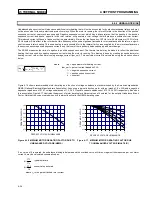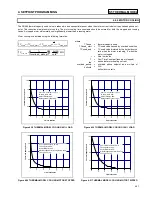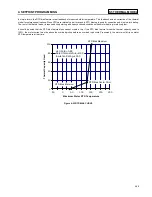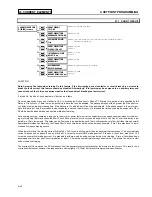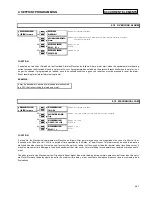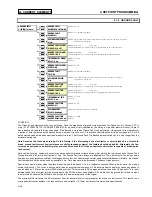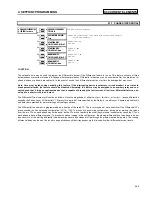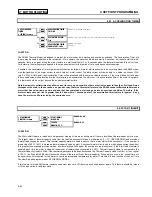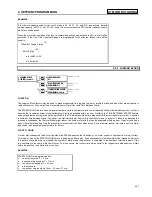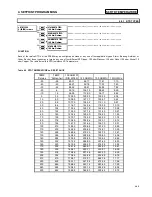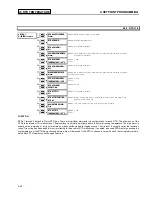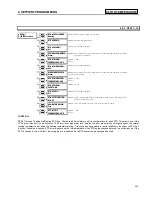
S5 THERMAL MODEL
4. SETPOINT PROGRAMMING
4-36
4.6.4
UNBALANCE BIAS
Unbalanced phase currents will also cause additional rotor heating that will not be accounted for by electromechanical relays and may
not be accounted for in some electronic protective relays. When the motor is running, the rotor will rotate in the direction of the positive
sequence current at near synchronous speed. Negative sequence current, which has a phase rotation that is opposite to the positive
sequence current, and hence, opposite to the rotor rotation, will generate a rotor voltage that will produce a substantial rotor current.
This induced current will have a frequency that is approximately 2 times the line frequency, 100 Hz for a 50 Hz system or 120 Hz for a
60 Hz system. Skin effect in the rotor bars at this frequency will cause a significant increase in rotor resistance and therefore, a signifi-
cant increase in rotor heating. This extra heating is not accounted for in the thermal limit curves supplied by the motor manufacturer as
these curves assume positive sequence currents only that come from a perfectly balanced supply and motor design.
The SR469 measures the ratio of negative to positive sequence current. The thermal model may be biased to reflect the additional
heating that is caused by negative sequence current when the motor is running. This biasing is done by creating an equivalent motor
heating current rather than simply using average current (Iper_unit). This equivalent current is calculated using the equation shown
below .
(
)
Ieq
I
k I
I
per unit
=
+
_
(
/ )
2
2
1
2
1
where:
Ieq = equivalent motor heating current
Iper_unit = per unit current based on FLA
I
2
= negative sequence current
I
1
= positive sequence current
k = constant
Figure 4-16 shows recommended motor derating as a function of voltage unbalance as recommended by the American organization
NEMA (National Electrical Manufacturers Association). Assuming a typical induction motor with an inrush of 6 x FLA and a negative
sequence impedance of 0.167, voltage unbalances of 1,2,3,4,5 % equals current unbalances of 6,12,18,24,30% respectively. Based on
this assumption, Figure 4-17 illustrates the amount of motor derating for different values of k entered for the setpoint Unbalance Bias k
Factor. Note that the curve created when k=8 is almost identical to the NEMA derating curve.
PERCENT VOLTAGE UNBALANCE
DERATING FACTOR
0.70
0.75
0.80
0.85
0.90
0.95
1.00
0
1
2
3
4
5
Figure 4-16 MEDIUM MOTOR DERATING FACTOR DUE TO
UNBALANCED VOLTAGE (NEMA)
PERCENT VOLTAGE UNBALANCE
DERATING FACTOR
0.70
0.75
0.80
0.85
0.90
0.95
1.00
0
1
2
3
4
5
k=2
k=4
k=6
k=8
k=10
Figure 4-17 MEDIUM MOTOR DERATING FACTOR DUE
TO UNBALANCED VOLTAGE (MULTILIN)
If a k value of 0 is entered, the unbalance biasing is defeated and the overload curve will time out against the measured per unit motor
current. k may be calculated conservatively as:
k
I
LR
=
175
2
typical estimate
k
I
LR
=
230
2
conservative estimate
where
I
LR
is the per unit locked rotor current.
Содержание SR469
Страница 7: ......
Страница 19: ...2 INSTALLATION MECHANICAL 2 5 2 1 5 TERMINAL LOCATIONS Figure 2 11 TERMINAL LAYOUT...
Страница 21: ...2 INSTALLATION ELECTRICAL 2 7 Figure 2 12 TYPICAL WIRING DIAGRAM...
Страница 32: ...ELECTRICAL 2 INSTALLATION 2 18 2 2 14 TYPICAL 2 SPEED MOTOR WIRING...
Страница 39: ...OVERVIEW 3 SR469 OPERATION 3 6 yy SETPOINTS yy S1 SR469 SETUP...
Страница 104: ...4 SETPOINT PROGRAMMING S11 MONITORING 4 65 Figure 4 24 TRIP COIL SUPERVISION...
Страница 113: ...S12 ANALOG I O 4 SETPOINT PROGRAMMING 4 74...
Страница 244: ...8 469PC PROGRAM WAVEFORM CAPTURE 8 13 Figure 8 11 WAVEFORM CAPTURE...















